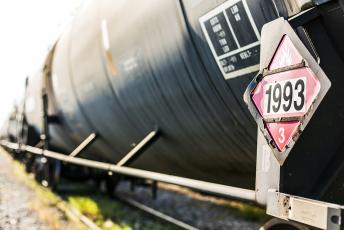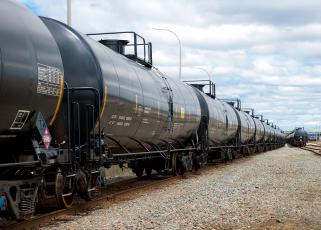Alongside the publication of AFPM’s new study, “The Fuel & Petrochemical Supply Chains: Moving the Fuels & Products That Power Progress,” Flash Point interviewed leaders working on U.S. midstream infrastructure issues. Today, we’re going to hear from Sean Strawbridge, CEO of the Port of Corpus Christi as part of our series highlighting the U.S. fuel and petrochemical supply chains.
The Port of Corpus Christi is the fourth-largest port in the U.S. by tonnage and a gateway to international marine commerce through the Gulf of Mexico. The Port of Corpus Christi Authority oversees the movement of 600 million barrels of crude and petroleum products annually, and it is host to what will be the largest LNG export terminal in the region.
AFPM: Tell me about the Port of Corpus Christi and how you enable energy products to move about.
Sean Strawbridge: The Port of Corpus Christi is strategically located between Mexico and Houston, Texas. Our proximity to two of the largest energy producing fields – the Eagle Ford Shale and the Permian Basin – positions the port as a gateway for the international markets. We are fairly diverse in that we handle a multitude of commodities, so we are what you call an omniport. We have tremendous amounts of crude oil that move through our port facilities, and we do a fair amount of NGLs, propane, butanes and others. We also have a sizeable refining center with about one million barrels of refining capacity per day. Additionally, we have a tremendous amount of other commodities, including petrochemicals, polymers and steel.
We are primarily an export port with about 2:1 volume of exports versus imports. From a volume metrics standpoint, we are the fourth largest in the country – in excess of 100 million revenue tons a year. We are a growing port, and we feel comfortable about our role as a strategic player in the country’s energy renaissance narrative.
AFPM: Can you give us some details on the Harbor Bridge and the channel deepening?
Strawbridge: The ports are way points. In other words, we are not origins or destinations – we are usually way points for goods movement, and goods have to move fluidly in order to remain competitive. We’ve seen vessel technologies advance significantly over the past couple decades, with vessels getting larger and drawing more water and carrying more goods. Infrastructure has struggled globally to keep up with these emerging vessel technologies, whether it is container ships, cruise ships, or in our case, bolt tankers. We need to do our part to build the necessary infrastructure to handle those larger ships, if we want to remain competitive.
A lot of people have talked about the Panama Canal and its expansion, but that was not the game changer, the game changer was the vessels. The Panamanian government recognized that if they did not make the investments to be able to handle the larger ships, then they would be relegated to a niche player in the global trade lanes.
It’s been an arms race around the world to build the necessary and supporting infrastructure. We’re very fortunate because we’ve got our position relative to the largest energy producing fields, and that makes us an attractive area for not only our investments in the infrastructure but also our customers’ investments. Right now, there are over 50 billion dollars of private industrial projects that are in various stages of construction or completion around the Corpus Christi ship channel, including AFPM members like Exxon, Valero, Cheniere with their LNG facility, and OXY with their Ingleside Energy Center. We are seeing tremendous investment there as this country continues to forge a path with what I’ll call “energy resiliency.” We are on track to be a net exporter of energy by 2022. The last time this country was a net exporter of its energy production was 1953, so this is certainly an interesting time to be in the industry.
AFPM: What does the VLCC under construction at Corpus Christi mean for your port and the industry?
Strawbridge: As I said, you have to be able to handle the larger classification of vessels. The big energy consumption markets are, of course, in Asia – and Asia is demanding these larger vessels along with larger single shipments of crude or finished products. The very large crude carriers are just another element that we want to put into our portfolio to continue to make our customers competitive.
LOOP [Louisiana Offshore Oil Port] is primarily designed to handle the offshore production. LOOP does have some advantages in that it is deep water and can handle VLCCs, but LOOP is also limited in that it’s primarily set up for offshore production. Today the economics of a Permian barrel don’t make sense going to LOOP. The incremental transportation cost to move a barrel into LOOP far exceed whatever savings you may have by loading a VLCC at LOOP. Asian customers are very particular in their asks. They want a segregated barrel, a very narrow spec, and they may want specific blending – but LOOP doesn’t afford that. LOOP uses the salt caverns as its storage, and I believe the capacity there is about 50 million barrels, so you get a fairly wide spec. You pretty much get what you get when you buy a LOOP barrel.
When you’re buying a barrel through Corpus, you know it’s an Eagle Ford barrel or a Permian barrel. We have a tremendous amount of segregation capabilities, so it’s a neat barrel and that’s really what the Asian consumer wants. They are very demanding in that, and we like that from our standpoint. The VLCCs also demand about 75 feet of water, and we’re currently embarking on a 54-foot deepening project. We’ve still got a ways to go to get to 75 feet to fully load a VLCC. Until we can get there, we have to partially load the VLCCs and reverse lighter them offshore, which certainly adds some cost to that type of operation. Our goal is to try to have VLCC capable facilities to load fully within the next three to five years.
AFPM: Can you talk about the permitting process and the ways to improve that process?
Strawbridge: If you’re talking about the permitting process for the Army Corps of Engineers, there’s a lot of work to be done there. It is a lengthy process, particularly if you are planning to have the Corps do the work. Is there opportunity for improvement there? Certainly. We are working with lawmakers to make some adjustments in the board of legislation that will allow for a more streamlined permitting process if we wanted to actually do the work ourselves.
As it relates to permitting on the uplands operations, the Texas Commission on Environmental Quality (TCEQ) does a pretty good job on permitting, and they’re user-friendly relative to other states. I’m a native Californian, but I’m Texan by choice. My time in California certainly taught me a lesson in what not to do, but we’re pretty happy with the relationship we have with the TCEQ. We’ve worked really well with them and with our customers. Oftentimes, we act as a liaison between our customers and the state agencies to help facilitate the permitting. But, at the federal level, there is more to be done.
AFPM: What have been some of the challenges you encountered during the port’s growth? And, what can state and federal governments do to facilitate growth in our main stream ports like Corpus Christi?
Strawbridge: The Port of Corpus Christi is a government agency, but we’re unique in that we’re an independent political district in the state of Texas and operate as a for-profit agency and enterprise fund. Unlike private industry, our profits are not distributed to shareholders. Our shareholders are our customers, the stakeholders and the users of the port. We take those profits and we reinvest them into infrastructure to support commerce, economic development and growth in the region. We certainly want to do that in a responsible and sustainable way. We are working with the TCEQ or the EPA to ensure that we don’t have too much regulation, but we are also demonstrating stewardship above and beyond what’s required. This is something that we promote and certainly help our customers with.
If you look at surface transportation projects in this country, the Department of Transportation and the Federal Highway Administration grant dollars to the states, and the states execute on those projects. Texas and the Department of Transportation receive about four billion dollars per year in federal money that is used to execute surface transportation projects. When it comes to maritime infrastructure, it’s quite different. The federal government allocates funds to the Army Corps of Engineers, and it’s the Corps that does that work. Unfortunately, the Army Corps of Engineers is an extremely overburdened, under-resourced agency. Until we see some major changes in the way they do business, we’re likely going to see some difficulty in the execution of projects that the mid-stream sectors and ports need.


